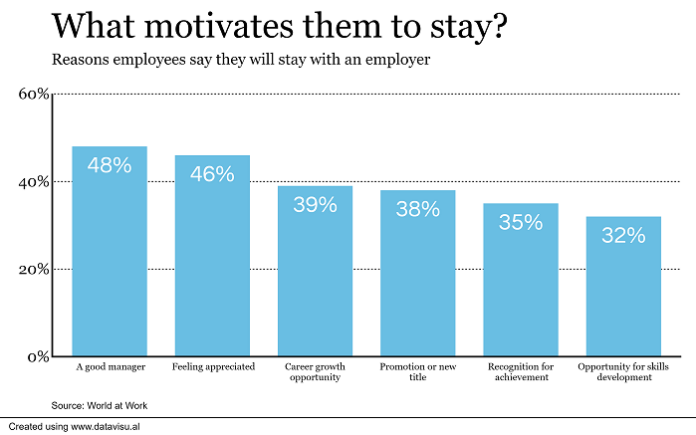
It was back in 1997 when McKinsey Quarterly first introduced us to the idea of a “War for Talent.” I’m not wild about using war as an analogy, but given how sticky the term has been over the past two decades, please try and indulge me in this one instance. During the late ’90s, the idea that talent, rather than other traditional strategic advantages (such as technology, supply chain, scale, brand, etc.) could prove to be the “X factor” for organizations to succeed was a fairly progressive notion. Fast forward to today, and globalization (read: the offshoring of rote jobs) has only accelerated America’s knowledge worker-fueled economy. HR organizations have invested massive amounts in building out talent management and learning and development functions in efforts to maximize their return on talent.
HR professionals around the country (and the world) are still very much in the process of recouping from a bewildering 13 months of layoffs, forced remote work, workplace and employee safety protocols, employee fury over inequitable treatment of underrepresented minorities and much more. Yet, we find ourselves having to shake it off and maintain our situational awareness–because yes, at this very moment, even if we might not know it yet, the Second War for Talent has begun.
Up to half of employees might quit their jobs if hybrid work arrangements are not provided, and studies show that one in four employees plans to leave their jobs, post-pandemic. Just imagine if this were to happen to your own organization!
The projections for the economy are very bullish, which economists predict will serve to significantly increase demand for talent (and if we experience inflation, this will only grow more challenging), far outstripping our supply of available labor. Unlike in 1997, employees now have orders of magnitude more information at their fingertips, thus resulting in a seller’s market for labor. Switching costs for employees have never been lower, as remote work has made the process of taking an interview during the day a breeze and starting a new role as simple as shipping back one laptop and then receiving another in its place. Plus, employers are competing for (and poaching) employees from across the country and around the world, unlocking massive career opportunities for employees who are no longer tethered to geography.
Employers have often relied on physical office-based tactics and perks to create a compelling employee experience that manages to both engage and retain their employees, with few organizations ever thoughtfully designing and deploying a hybrid or pure remote employee experience that is unique and sticky, and therefore further exposing the risk of employee attrition in this new paradigm.
Back in 1997, the primary way for organizations to win the War for Talent was by recruiting. Transforming sterile, tedious and mechanical personnel-era practices into something compelling involved the deployment of massive amounts of new recruiting technology, sexy employer branding on websites and social media, an empathetic candidate experience, leveraging data and so much more.
But this Second War for Talent is unlikely to be won on the recruiting front. Much like real-world wars between militaries, over time, technology and other conditions will change the tactics that are used to win. This time around, it is going to be difficult to out-recruit the deep-pocketed tech firms that are fueled by mind-boggling venture capital investments, SPAC-based public offerings, an overheated stock market and a massive transfer of spending toward technology. Many of these organizations are even willing to provide insane compensation packages and perks that other lower-margin businesses could never make viable. And if you’re not one of these flush firms, then trying to win this war by recruiting is going to be like bringing a knife to a gunfight.
 So, what are we to do? The answer is simple, but not easy: We follow the same business practices that make so many of these Software-as-a-Service (SaaS)-based businesses hugely profitable and valuable: Focus on retention. In these cases, recurring revenue streams are built on maximizing the lifetime value of a customer and ensuring that customers (either consumers or other businesses) remain happy (which is often measured via Net Promoter Score) and retain their subscriptions as a cornerstone of their business model. HR would be well-served in choosing to reframe their employees as talent customers offering their services to the organization, with HR’s goal being to extend the length of tenure for valued employees.
So, what are we to do? The answer is simple, but not easy: We follow the same business practices that make so many of these Software-as-a-Service (SaaS)-based businesses hugely profitable and valuable: Focus on retention. In these cases, recurring revenue streams are built on maximizing the lifetime value of a customer and ensuring that customers (either consumers or other businesses) remain happy (which is often measured via Net Promoter Score) and retain their subscriptions as a cornerstone of their business model. HR would be well-served in choosing to reframe their employees as talent customers offering their services to the organization, with HR’s goal being to extend the length of tenure for valued employees.
That’s why employee retention will need to become HR’s north star metric, a number that everyone in the organization knows and is keenly focused on. While most mid- and large-sized organizations are going to have a head of talent acquisition, very few are going to have a head of talent retention, which is a concept that should be explored. Retention is where the rubber really meets the road: manager relationship, career growth, fair compensation, culture, DEI, tools/resources, brand/reputation, flexibility and pride in the work they’re doing. And the business case is obvious, as the cost of turnover is often 50%-200% of the annual salary of a departed colleague, according to Gallup. HR will be required to double-down on employee experience efforts, making them more focused on what employees want/need, rather than simply defining what the organization is offering from the top-down.
I’ve seen engagement survey results and exit interview findings during my days as an SVP of HR and also in my work with countless organizations, and almost without exception, every organization’s data points to career development as being a top-three driver in the form of providing employees feedback, learning opportunities, quality manager relationships, the chance to grow and the feeling that they have a bright future ahead of them at the organization as a cornerstone of engagement and retention. At PILOT we often say, “If they ain’t growin’, they be goin’.” With all this in mind, HR must work to deliver a step-level improvement in employee perceived value of career development opportunities in the years ahead if they are to truly win this Second War for Talent.





